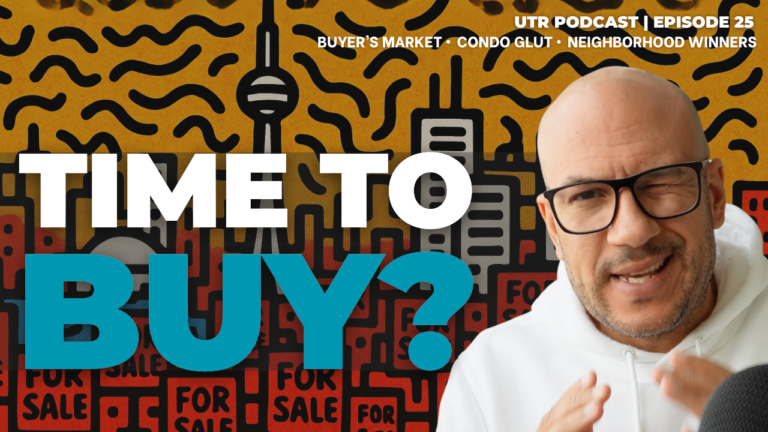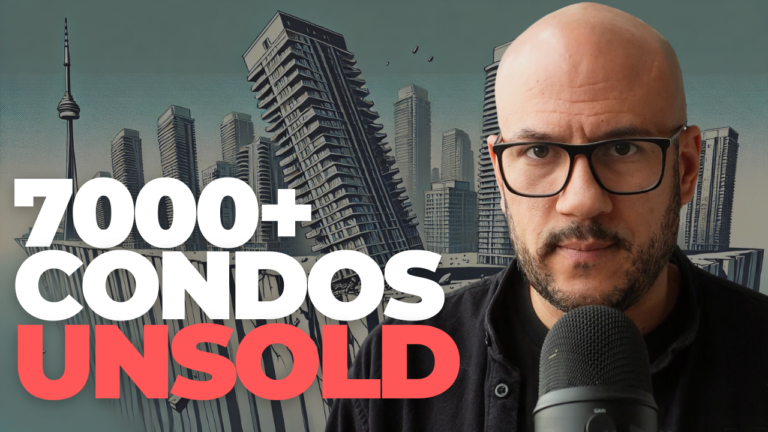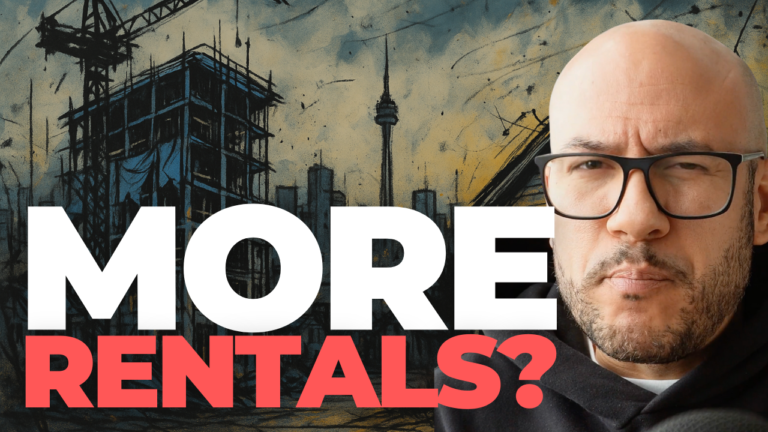Toronto’s Condo Market Crisis: What Went Wrong?
Toronto’s condo market crisis is unfolding in real-time, with just under 6,000 units sitting unsold—many of them small, investor-focused condos that aren’t meeting buyer demand. Over 50% of these units are under 800 sq. ft., and developers seem more focused on maximizing profits than creating livable spaces.
While interest rates, supply chain disruptions, and inflation have all played a role, another factor is being overlooked: government policies and global trade dynamics. Trump’s tariffs on building materials years ago contributed to rising construction costs, and now with investors struggling to sell, the cracks in the system are more visible than ever.
So, why are so many condos sitting empty? And more importantly, how do we fix it? Let’s break it down.
Toronto Condo Market: A Flooded Inventory with No Buyers
1. Over 6,000 Unsold Condos
The numbers don’t lie—Toronto’s condo market is overflowing with inventory. With just under 6,000 units for sale, you’d expect buyers to be rushing in to take advantage of lower prices. But instead, many are hesitant, and investors are struggling to offload their properties.
2. Toronto Condos Are Still Overpriced
Let’s do the math:
- The average rent for a one-bedroom condo in Toronto is $2,400/month.
- A buyer putting 20% down would have a monthly mortgage of ~$2,200.
- With only 5% down, that cost jumps to over $2,600/month—before condo fees, taxes, and maintenance.
The reality? Buying isn’t much cheaper than renting, and high maintenance fees (which, by the way, tend to double every 8 years) make it even harder to justify a purchase.
3. Short-Term Rental Crackdown Hurt Investors
For years, investors relied on Airbnb and short-term rentals to offset costs. But with new restrictions limiting short-term rentals to primary residences only, many investors lost a key revenue stream.
This means a lot of these small, investor-friendly units don’t make financial sense anymore—which is why we’re seeing a rush of listings but no buyers.
Why Did This Happen? (The Bigger Picture)
1. Developers Built for Investors, Not End-Users
Toronto’s condo boom was fueled by investors, not people looking for homes. Developers maximized profits by building smaller units that were easy to rent out. But now that investor demand is cooling, we’re left with a flood of tiny, impractical units that families don’t want.
2. Trump’s Tariffs and Inflation
Wait, what does Trump have to do with this?
Well, tariffs on building materials introduced during Trump’s presidency drove up construction costs—and many of those costs were passed on to buyers. Even after the U.S. election, supply chain issues continued to push prices up, making Toronto’s already expensive condo market even worse.
Now, with higher borrowing costs and global inflation, prices simply don’t make sense anymore—for investors or end-users.
3. Interest Rates Changed the Game
Low interest rates fueled rampant real estate speculation. But as rates climbed over the past two years, carrying costs increased, and investors realized their margins were razor-thin.
This led to a sell-off—and now, the market is oversaturated with condos nobody really wants.
How Do We Fix Toronto’s Condo Market?
We can’t change the past, but here are some ways to reset the market and make housing actually livable again.
1. Let the Market Correct (But Will It Work?)
A price correction is happening—but slowly. While some sellers are dropping prices, others are holding out, hoping for a market rebound.
The question is: do we let prices drop naturally, or do we need intervention?
2. Reverse the Foreign Buyer Ban?
This is controversial, but let’s be real: foreign investors played a huge role in Toronto’s real estate market. By cutting them off, we removed a major source of demand for these smaller, investor-friendly condos.
Would bringing back foreign buyers help stabilize prices? Maybe. But politically, it’s a tough sell.
3. Get Institutional Investors Involved
Pension funds and real estate investment trusts (REITs) are buying up entire rental buildings—so why aren’t they buying Toronto condos?
If institutional investors stepped in to bulk-purchase unsold condos, it could stabilize the market while keeping rental supply high. But if they haven’t done it already, there’s probably a reason.
4. Bring Back Short-Term Rentals (With Taxes)
Instead of banning short-term rentals, what if Toronto regulated and taxed them?
Many global cities allow short-term rentals with strict rules—but instead of outright banning them, they generate tax revenue from them.
If Toronto took this approach, it could open up another revenue stream while giving investors a way to make their properties profitable again.
5. Fractional Ownership: A Wild Idea?
What if, instead of one investor buying a unit, 10, 50, or even 100 people co-owned it?
Fractional ownership could make real estate more accessible, reduce financial risk, and create new investment opportunities.
It’s not a common model in Canada, but given where the market is heading, maybe it should be.
Final Thoughts: Where Does Toronto’s Condo Market Go From Here?
The Toronto condo market crisis isn’t going away overnight. With high inventory, stalled sales, and shifting investor sentiment, we need serious changes to make this market work again.
But here’s the thing: I don’t think end-users should be the ones stuck with the burden of fixing it.
Investors built this market. Investors should be the ones absorbing the risk.
In the meantime, if you’re thinking of buying in this market, hit me up—I’ve been helping clients buy and sell condos for over 13 years.
Oh, and if you’re looking for real-time AI insights on Toronto condos, check out Valery.ca. Asking prices are great, but knowing what condos actually sell for is the real game-changer.
📩 Want expert guidance? Let’s connect.


